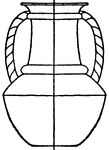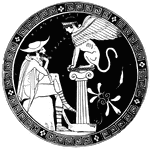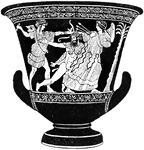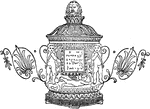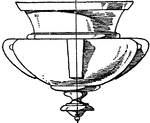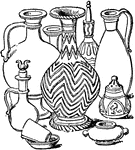
Alabaster
A form of silicate that is found in great abundance throughout Europe. It is white and can be scratched…

Vase Alabastron
This vase alabastron is made out of iridescent glass. It has a bag-like body with no foot and a narrow…
Alabastrum
"A small elongated vase for unguents or perfumes, rounded at the bottom and provided with a broad rim…

Amphora
"A jar with two handles; Among the Greek and Roman, a vessel, usually tall and slender having two handles…
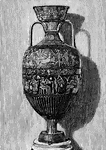
Amphora
"A jar with two handles; Among the Greek and Roman, a vessel, usually tall and slender having two handles…

Amphora
Amphoræ are jars with narrow necks and two handles, used by ancient Greeks for transporting oil…

Amphora
Amphoræ are jars with narrow necks and two handles, used by ancient Greeks for transporting oil…

Amphora
Amphoræ are jars with narrow necks and two handles, used by ancient Greeks for transporting oil…

Clay Amphora
This clay amphora is painted in polychrome (multicolors). It has an Alexandrian style band-shaped handles.

Clay Amphora
This clay amphora is painted in polychrome (multicolors). It has an Alexandrian style band-shaped handles.

Egyptian Amphora
This Egyptian amphora is a vase with a cover intended for water, oil or wine. It was found in Thebes,…

Egyptian Amphora Shape
This Egyptian amphora is a vase with a cover intended for water, oil or wine. It was found in Thebes,…

Roman Amphora
This Roman Amphora is unpainted made out of red clay. The neck of this vase is narrow with a thick rim.

Roman Amphora
This Roman Amphora is an unpainted vase made out of yellow clay. It was found in the area near Aquileia,…
Roman Amphora
This Roman Amphora is made out of iridescent glass and was found in Pompeii, Ancient Rome.

The Armistead Vase
The grateful citizens of Baltimore presented Colonel Armistead with an elegant silver vase, in the form…

The Biddle Urn
During the War of 1812, James Biddle was first lieutenant in USS Wasp. He led the boarding party against…

Brass Vase
"Brass Vase, pierced and gilt; 17th century Persian work." —The Encyclopedia Britannica, 1903

Chelys
"Chelys, from a vase in the British Museum, where also are fragments of such an instrument, the back…

Chrismatory
A receptacle for the chrism, or holy oil, used in the services or the Roman Catholic and Eastern Churches.

Clay Urn
A vase, ordinarily covered and without handles and usually has a narrowed neck above a footed pedestal.

Coralberry
The Aechmea fulgens of coralberry is a bromeliad which is often used as a decorative plant.
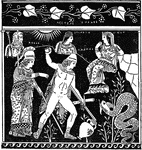
Cadmus and the Dragon
"Cadmus and the Dragon. (From a vase-painting at Naples.)" — The Delphian Society, 1913

Margin Drawing
This margin drawing was created by German artist Albrecht Dürer in 1515. It is found in the prayer…

Two Men Drawing
Albrecht Meyer on right sketches plants for the De Historia Stirpium published in 1542. Heinrich Füllmaurer,…

Esther Approaches the King and is Welcomed
"Now it came to pass on the third day, that Esther put on her royal apparel, and stood in the inner…
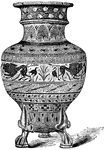
Fictile Vase
"Fictile vase, from Athens. Design in black, on drab ground." — Encyclopedia Britanica, 1893

Egyptian Glassblowers
"The form of the bottle and the use of the blow-pipe are unequivocally indicated; and the green hue,…
Greek Soldiers in Arms
"From a Greek vase of about the time of the battle of Marathon."—Webster, 1913
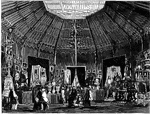
The Hall of the Zollverein
Many intricate vases, urns and statues are on display in this hall. Several framed pictures dot the…




